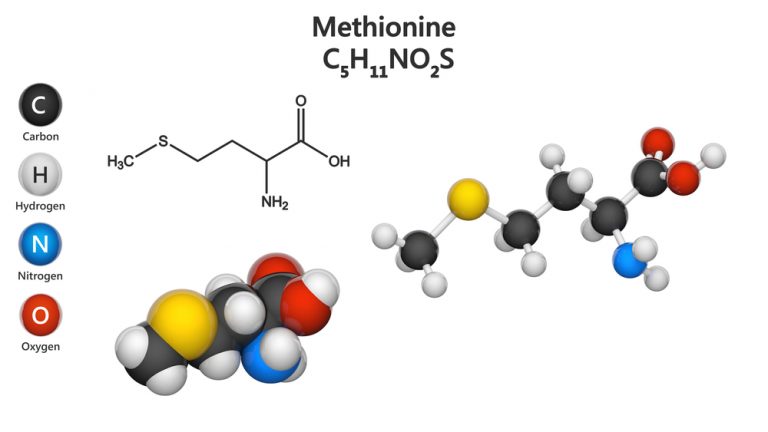Methionine is an essential yet one of the most underestimated amino acids, which functions resolve mainly around homocysteine, an amino acid that in excess increases the risk of cardiovascular diseases such as atherosclerosis. This is one of the diseases that certainly should not be underestimated. Moreover, we should always be aware of its threats and preferably prevent it. One way to decrease the risk of atherosclerosis is sufficient methionine intake, so it is worth knowing the properties of this amino acid, and above all, understand why we need it to effectively fight excessive homocysteine levels.
Functions of methionine
Methionine belongs to the group of essential amino acids. It contains sulfur and is used mainly for the translation process in protein synthesis, and it is the first amino acid to be attached during the process of building a polypeptide chain that will build the final protein.
As methionine is an organic chemical compound, it can be found in various forms, including S-adenosylmethionine, which is a derivative of adenosine and methionine. S-adenosylmethionine is the metabolically active form of methionine, which is a donor of methyl (-CH3) groups. Methyl groups are transferred to amine compounds with the participation of enzymes of the methyltransferases group. In this respect, methionine takes an active part in the body’s detoxification process, as well as regulating keratinization - the process of the epidermis, hair, and nails production.
Moreover, methionine is an element necessary for the synthesis of nucleic acids, choline, glycine, creatine phosphate, and adrenaline as it increases the synthesis of glutathione, i.e. L-gamma-Glutamyl-L-cysteinyl-glycine. Glutathione is an organic chemical compound that, through its reduced form and free thiol groups, supports the reduction of peroxides, so that it eliminates free radicals while protecting the remaining cells from the harmful effects of their activity.
Dietary sources of methionine
Methionine is supplied to the human body mainly through dietary sources. Undoubtedly, for people without adequate knowledge, the name of this organic compound does not reveal in any way in which products we can find it.
The main dietary source of methionine are meat products, but for people whose diet does not include meat, an ideal alternative are legumes such as beans, peas, and lentils, which, despite the fact that they belong to vegetables, contain a significant amount of methionine. The only exceptions are sesame seeds and Brazil nuts.
Effect of methionine in the human body
The key to understanding methionine activity in the human body, and all the processes it takes part in, is getting along the different stages of methionine formation. so it is right to show the cycle of methionine, homocysteine, and cysteine transformations, which are collectively called the methylation cycle.
The first stage of the cycle is the production of glutathione, a very important cellular antioxidant, closely related to the absorption of minerals such as copper and zinc.
Next, S-adenosylmethionine (SAMe) is produced, which is the most effective donor of the methyl group in the body, protecting the liver and enabling numerous chemical transformations, as well as being the most effective antidepressant and, in a way, an analgesic for joint ailments.
As the rest of the methylation cycle is getting much more complicated, we have covered it in our other article, related strictly to methylation disorders.
Click to know more about the methylation cycle.
Methionine for athletes
The use of methionine in bodybuilding is also worth mentioning. Considering the role of L-methionine in the process of protein production, some professional bodybuilders take this amino acid as a dietary supplement, hoping for fast muscle mass gain.
L-methionine, as already mentioned, belongs to the amino acids in the peptide chain structure, and its deficiency can lead to impaired ability to synthesize new proteins, which would consequently lead to reduced muscle growth and recovery after training.
For professional bodybuilders, it is recommended to consume at least 1 g of protein per kilogram of lean muscle mass. However, despite many efforts, no scientific study conducted to date has shown that increased intake of L-Methionine leads to increased muscle protein synthesis.






